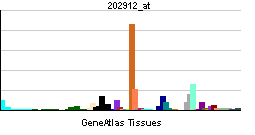Adrenomedullin
| Adrenomedullin | |||||||||||
|---|---|---|---|---|---|---|---|---|---|---|---|
| Identifiers | |||||||||||
| Symbols | ADM ; AM | ||||||||||
| External IDs | Template:OMIM5 Template:MGI HomoloGene: 873 | ||||||||||
| |||||||||||
| RNA expression pattern | |||||||||||
 | |||||||||||
| More reference expression data | |||||||||||
| Orthologs | |||||||||||
| Template:GNF Ortholog box | |||||||||||
| Species | Human | Mouse | |||||||||
| Entrez | n/a | n/a | |||||||||
| Ensembl | n/a | n/a | |||||||||
| UniProt | n/a | n/a | |||||||||
| RefSeq (mRNA) | n/a | n/a | |||||||||
| RefSeq (protein) | n/a | n/a | |||||||||
| Location (UCSC) | n/a | n/a | |||||||||
| PubMed search | n/a | n/a | |||||||||
|
WikiDoc Resources for Adrenomedullin |
|
Articles |
|---|
|
Most recent articles on Adrenomedullin Most cited articles on Adrenomedullin |
|
Media |
|
Powerpoint slides on Adrenomedullin |
|
Evidence Based Medicine |
|
Clinical Trials |
|
Ongoing Trials on Adrenomedullin at Clinical Trials.gov Trial results on Adrenomedullin Clinical Trials on Adrenomedullin at Google
|
|
Guidelines / Policies / Govt |
|
US National Guidelines Clearinghouse on Adrenomedullin NICE Guidance on Adrenomedullin
|
|
Books |
|
News |
|
Commentary |
|
Definitions |
|
Patient Resources / Community |
|
Patient resources on Adrenomedullin Discussion groups on Adrenomedullin Patient Handouts on Adrenomedullin Directions to Hospitals Treating Adrenomedullin Risk calculators and risk factors for Adrenomedullin
|
|
Healthcare Provider Resources |
|
Causes & Risk Factors for Adrenomedullin |
|
Continuing Medical Education (CME) |
|
International |
|
|
|
Business |
|
Experimental / Informatics |
Adrenomedullin is a peptide associated with pheochromocytoma. It was discovered in 1993.[1]
Adrenomedullin (AM) is a ubiquitously expressed peptide initially isolated from phaechromyctoma in 1993 (Kitamura et al., 1998). Since its first report, studies examining the effects of adrenomedullin have mushroomed, highlighting its role in a number of diseases. Recently a second peptide AM2 has been recognised, exhibiting similar functions (Fujisawa et al., 2004).
The Adrenomedullin Peptide
The human AM gene is localized to a single locus on Chromosome 11 with 4 exons and 3 introns. The AM gene initially codes for a 185-amino acid precursor peptide [3], that can be differentially excised to form a number of peptides, including an inactive 53-amino acid AM, e PAMP, adrenotensin and AM95-146. Mature human AM is activated to form a 52 amino acid, 6-amino acid ring, that shares moderate structural similarity to the calcitonin family of regulatory peptides (calcitonin, CGRP and amylin). Circulating AM consists of both amidated (mature) and the glycated form (inactive, with the latter comprising the major form (85%) [5]. The measured to have a plasma half-life of 22min, mean clearance rate of 274 mL/kg/min, and apparent volume of distribution of 880+/- 150 mL/kg (Meeran et al., 1997). Mature AM is metabolised via aminopeptidase action.
Receptors of Adrenomedullin
At present AM is believed to function through through the combination of a few combinations of the calitonin receptor like receptor (CL) and receptor activity-modifying proteins (RAMP) complexes, as well as CGRP receptors. It is worth noting that unlike the classical one ligand-one receptor notion of receptor signalling, the interaction of both CL and RAMP at the membrane, is required for AM to mediate its action. The outcome of AM stimulatation of its receptor is the cellular production of both cyclic AMP (cAMP) and nitric oxide production. Some may find the production of these inside the cell to be at odds, since often they have opposing effects, but as yet, the timing of these effects remains to be studied.
The physiological functions of Adrenomedullin
AM was initially identified as a vasodilator, some have cited this as the most potent endogenous vasodilatory peptide found in the body (Cockcroft et al., 1997). Differences in opinion regarding the ability of AM to relax vascular tone arises from the differences in the model system used (Hamid and Baxter, 2005). Other effects of AM include increasing the tolerance of cells to oxidative stress and hypoxic injury and angiogenesis. AM is seen as a positive influence in diseases such as hypertension, myocardial infarction, chronic obstructive pulmonary disease and other cardiovascular diseases, whereas it can be seen as a negative factor in potentiating the potential of cancerous cells to extend their blood supply and cause cell proliferation.
References
- ↑ "Quantifying angiogenesis in VEGF-enhanced tissue-engineered bladder constructs by dynamic contrast-enhanced MRI using contrast agents of different molecular weights". J Magn Reson Imaging. PMID 17139634.
Further reading
- Cao et al., Regulated Peptide, 113(1-3),109-114. 2003.
- Cockcroft et al., Br J Clin Pharmacol. 1997 Jul;44(1):57-60.
- Fujisawa Y et al., Eur J Pharmacol. Aug 16;497(1):75-80. 2004.
- Hamid SA, Baxter GF, Pharmacol Ther. Feb;105(2):95-112.2005.
- Kitamura et al., Biochem Biophys Res Commum, 244(2), 551-555. 1998.
- Meeran K et al., J Clin Endocrinol Metab. Jan;82(1):95-100. 1997
External links
- Adrenomedullin at the US National Library of Medicine Medical Subject Headings (MeSH)
| This protein-related article is a stub. You can help Wikipedia by expanding it. |